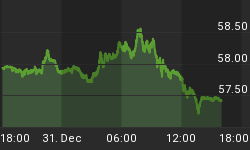Although the S&P 500 and Dow industrials closed at record highs and rose for a third consecutive week, the gains were not as robust as those of the prior two weeks. In the updated performance chart below most of the major equity indexes are showing their highest percentage return for the year. The Russell 2000 is the only laggard, as the index has just gotten back to breakeven year-to-date.

The S&P 500 has been hitting all-time highs over the past few weeks as the index has risen more than 9% since the middle of October when the market fell into correction territory. Now upward momentum is decelerating as the S&P 500 is getting overbought. The circles highlighted in the chart below are the current and most recent overbought signals; notice the index price normally pulls back at this level. Most probably the S&P 500 will stabilize to absorb recent gains and settle into a trading range before resuming a trend higher or lower.

The dollars inverse relationship to commodity assets is displayed in the chart below. You can see as the dollar surged higher it put downward price pressure on treasury securities and gold. Primarily due to the influence of quantitative easing (QE) treasuries actually held up relatively well, but precious metals really got hammered with gold falling to a four year low last week. Also notice in the chart as the dollar weakened at the end of last week commodity prices immediately strengthened. The dollar should not be expected to remain at an extreme lofty level and if it falls look for commodities prices to recover.

Market Outlook
As we reported recently, according to the Stock Trader's Almanac November maintains its status among the top performing months as fourth-quarter cash inflows from institutions drive November to lead the best consecutive three-month span November-January. November begins the 'Best Six Months' for the DJIA and S&P 500, and the 'Best Eight Months' for NASDAQ. Small caps come into favor during November, but don't really take off until the last two weeks of the year. November is the number-three DJIA and S&P 500 month since 1950. Since 1971, November ranks third for NASDAQ. November is second best for Russell 1000 and Russell 2000 third best since 1979. In midterm years, November's market prowess is relatively unchanged. DJIA has advanced in 12 of the last 16 midterm years since 1950 with an average gain of 2.5%. S&P 500 has also been up in 12 of the past 16 midterm years, gaining on average 2.7%. Small-caps perform well with Russell 2000 climbing in 6 of the past 8 midterm years, averaging 3.9%. The only real blemish in the November midterm-year record is 1974 (DJIA –7.0%, bear market ended in December).
So far in the fourth-quarter, a strong positive for the market is the small cap Russell 2000 index providing good results. We have been saying recently "...the small cap index has been a reliable predictor of market direction. It is reasonable to expect the large cap indexes to follow the Russell 2000 higher..." This prognostication proved to be correct as indexes reached all-time highs. Also, risk-off' categories that benefit from low inflation and are considered 'safe bets' continue to be market leaders

The updated chart below confirms last week's Momentum Factor ETF (MTUM) chart analysis "...confirms follow through on the most recent bullish trend. This should be considered a very strong trend because of multiple bullish accumulation days over the past few weeks, plus the strength indicator is not yet grossly overbought. Money managers have gotten back into the market and pushed stocks to lofty levels, as the market becomes more overbought expect the trend to convert to range-bound trading..."

Last week's analysis is still valid "...As has been the case for most of the past few years, you can see in the CBOE Volatility Index (VIX) graph below how the VIX shrinks to its low point every time the S&P 500 index makes another high. Expect the Volatility Index to remain subdued for a while as third-quarter earnings numbers have been relatively positive and the overall domestic economy continues to improve..."

The American Association of Individual Investor Survey (AAII) survey bullish percentage below is moving up towards an excessive level at the expense of the bearish number, which is extremely low. If inflated bullishness continues over the next few weeks the contrarian interpretation is that should be considered a strong indication of an imminent price pullback. The best near term bet is a range-bound trading environment as the market consolidates recent gains.

Third-quarter National Association of Active Investment Managers (NAAIM) exposure index averaged 71.09. Last week the NAAIM exposure index was 74.78%, and the current week's exposure is 77.68%. After falling to all-time lows in the middle of October the NAAIM index has climbed back up to its highest percentage since beginning of September. This suggests that money managers are becoming fully invested and any near term overall market gains will be incremental.


Trading Strategy
The Health Care sector has been one of the best performers recently, but is starting to fall after the U.S. Supreme Court agreed to hear a challenge to a key part of the Obamacare health law that, if successful, would limit the availability of federal health insurance subsidies for millions of Americans. As seen in the graph below DOW Industrials have been coming on strong over the past month and Utilities remain a top performing sector as it has been for the past few months. The recent market surge is also strengthening other S&P sectors such as Technologies, Consumer Staples and Financials. And we mentioned last week going long the S&P 500 index near the end of October and holding until just before Christmas has been successful 24 of the last 32 years, or 75.0% of the time.

Regards,
















